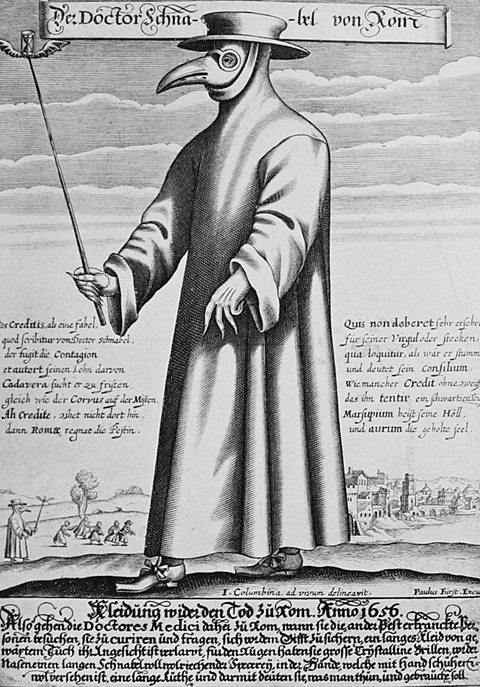The Great Plague of 1665

The plague returned to England in 1665. This outbreak became known as the Great Plague. It again had a devastating impact, killing 100,000 people in London. The cause of the spread was poor sanitation, which led to sewage and waste being discarded in the streets and river. This resulted in a significant increase in the population of black rats, which carried the bubonic plague bacteriaSingle-celled microorganisms, some of which are pathogenic in humans, animals and plants. Singular is bacterium.
As plague numbers started to rise, wealthy people, including Charles II, started to leave London. This risked spreading the disease across the country. The mayor of London stayed in the city. He helped to coordinate the response to the outbreak.
Government action
- There was a more organised and coordinated response to the plague outbreak in 1665-1666 than there had been in 1348-1349.
- As plague spread throughout Europe, the government introduced a quarantineA period of time during which a person is isolated due to a contagious disease - to prevent the disease being passed to other people. for all ships coming into London.
- If a household contained someone infected with the plague, the people were locked inside and a red cross was painted on their door.
- Searchers were employed to walk the streets, enter plague houses and identify the cause of death.
- There was a belief that stray cats and dogs were spreading plague, so the mayor of London ordered that they should all be killed. This may have actually made the outbreak worse, as the cats would have caught some of the rats that were responsible for spreading the disease.
- Belief in miasmaSmells from decomposing material, such as animal and human waste, that were thought to cause disease. meant people were ordered to light fires in the streets to create smoke. This was thought to mask the bad air believed to be causing the plague.
Knowledge of disease
Germs still had not been discovered, and this was the biggest problem in taking effective action to deal with the plague. Miasma, the four humours and God were still believed to be the main possible causes. This meant there was a limit to the effectiveness of cures and actions to try to limit the spread of the plague.
Cures
The cures in 1665-1666 were similar to those used in the 1348-1349 Black Death outbreak. bloodlettingThe process of bleeding a patient, either by using leeches or by cutting into a vein. and purgingIn historical medicine, the act of getting rid of fluid from the body for the purpose of balancing the four humours. Patients might take substances to make them vomit or empty their bowels. were widely used, showing that the four humoursFour bodily fluids – yellow bile, black bile, blood and phlegm – used in ancient times to analyse and describe people's state of health. were still believed to cause disease.
Plague doctors wore outfits to protect them from coming into contact with victims. They wore leather cloaks and masks containing herbs, to avoid them smelling the streets. They also wore gloves and hats so none of their skin was exposed to the air.
Impact
- The Black Death of 1348-1349 killed more people than the Great Plague of 1665-1666.
- This was in part due to a more organised government response in 1665-1666.
- There have been no more significant plague outbreaks since 1665-1666.
Although the The Great Fire of LondonA fire that started in a bakery on Pudding Lane in 1666 and quickly spread and destroyed around a third of London. was not the cause of the end of the outbreak, it did lead to significant rebuilding of the capital. The rebuilt city had no open sewers in the streets and buildings were more spread out. This reduced the chance of a further outbreak.